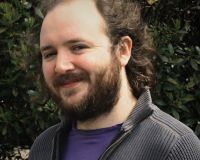Article
Posted on Thu 16 Feb 2023
Reflections on Random Selection
Our Studio Community Lead, Martin O'Leary, reflects on what we learned from the random selection process for our Winter Residencies

Photo by Mel Poole on Unsplash
Posted by

Martin O'Leary
As Head of Studio, Martin supports our community of residents in their creative and technical work.In 2022, as part of our annual Winter Residency programme, we experimented with a semi-randomised selection process for artists. Instead of asking for detailed proposals, applicants submitted short expressions of interest. From these, we randomly chose twelve artists to move forward to a shortlisting stage. Each artist was invited to visit the studio to discuss their ideas with our team, and final selection was based on a combination of a written proposal and interview. Each of the shortlisted artists was also paid a stipend for their time. This process was inspired by the work that Jerwood Arts have been doing with their 1:1 FUND.
We were blown away by the quality and depth of the conversations we were able to have with everyone on the shortlist, and we were delighted to be able to fund three wonderful artists through this scheme. Their projects have just begun, and you can read about their ideas in this blog post. Here though, we’d like to take a step back and talk a little bit about the process, why we did things the way we did, and how we might do things differently in the future.
When we launched the call, we wrote about our motivations for trying out random selection, including reducing bias in our decisions, and spending more time on the parts of the process which are more useful to applicants. One key point we identified was the huge amount of work that goes into unsuccessful applications. Since then, we’ve done some more research to quantify this unpaid labour. The results, quite frankly, shocked us.
In previous years, we’ve asked for a two-page proposal for the project. Based on informal conversations with applicants, we estimate that the typical applicant spends at least half a day (four hours) writing a proposal like this. When multiplied out across about a hundred applicants, that means four hundred hours, or ten working weeks, are spent preparing applications.
On the other side of the equation, the selected artists are paid for their time on the residency. Typically, we can pay two artists for twelve days each, for a total of twenty-four days paid time. This is less than half the amount of time spent preparing applications. A typical artist trying to make a living from funding opportunities like this would spend more than two thirds of their time working unpaid.
Obviously, this calculation doesn’t include the entire value of a residency programme. The artists we work with get support with production, publicity, documentation, as well as all the benefits of being embedded in our community. But if the main purpose of a residency programme is to give artists the time to make art, then we have to accept that we’ve been letting some people down.
We’re not alone in having made this mistake in the past. Our selection process was not unusual, and the numbers of applications we receive are fairly typical for a call like this. One could do a similar calculation for any number of opportunities offered by the arts sector, and while the numbers would vary somewhat, we believe the pattern is likely the same — in a lot of cases, artists are spending more time preparing funding applications than making art. This is one of the key things that we’ve learned through this process: while random selection may or may not be part of the solution, there is a deep underlying problem here that the arts sector needs to work towards solving.
For our new selection system, we aimed to have a form that could be filled out in five minutes. We didn’t quite get there — our data shows a median time of 7.8 minutes — but it’s a lot better than before, about a 30x reduction in the time per application. Even when we account for the much larger than usual number of applications we received this year, we still estimate that we’ve reduced the amount of time spent on applications by a factor of ten.
The time taken to prepare an application is just one aspect of the hardship that application processes put on artists. We’re all familiar with the cliché of staying up all night the night before an application deadline — many artists have to fit their practice around paying work and family life, and are forced to lose sleep to find time to complete applications.
Looking at applications from previous years, we know that 74% of applications come in on the last day before the deadline, and that 20% of applications are received at unsociable hours, which we define as between 10pm and 6am. With our modified process this year, these numbers have changed dramatically. Most applications came in well before the deadline, with only 17% received on the last day. Even better, only 12% of applications were received at unsociable hours, suggesting that it is much easier for artists to incorporate this process into their normal lives.
One of our goals with these changes was to reduce the amount of time, effort, and emotional energy that unsuccessful applicants had to invest in the process. We wanted the application process to be as simple and forgettable as possible. An unexpected consequence of this was that very few applicants took the time to fill out our evaluation form — understandable as this form was considerably longer than the application form itself! We received evaluation feedback from only 12% of applicants, far too few to draw any meaningful statistical conclusions.
Qualitatively though, we were able to learn some things. Most of the feedback we’ve received, both formally and informally, has ranged from curious and intrigued through to wildly positive. There is a widespread sense that arts funding is a broken system, and that experiments like this are a step forward, even if the details aren’t perfect. Survey respondents broadly agreed that the process was respectful of their time, and a majority were in favour of us using random selection in future calls.
However, we did receive negative feedback from several applicants. Some felt that their ideas were not being valued, and that we were not taking the process seriously. Others went so far as to accuse us of mocking and insulting artists. These criticisms can be difficult to hear, and we don’t feel that they reflect our intent. We clearly have work to do, continuing to communicate both the reasoning behind our decisions, and the respect we have for all of those who participated in the process.
We also received some more direct, actionable feedback. While we worked hard to simplify the application form itself, time constraints prevented us from doing the same for our call-out materials, which were based on those we used in previous years. A few applicants pointed out the incongruity in being asked to read a detailed 11-page brief before filling out such a short application form. This is an area where we want to focus our efforts for future calls — how can we supply all the information that applicants might need, without requiring them to spend time wading through extensive documentation?
Looking towards the future, we are excited to move forward with this process again. We didn’t get things perfect first time, and there are plenty of things we’d do slightly differently in future iterations. We’re also aware that this is a new way of working, both for artists and for funders. We don’t have a set of best practices to fall back on, or past experiences from which to draw. Our hope is that by sharing our journey we can help push these ideas forward and inspire others to try experiments of their own. The problems we face as a sector are real, and we don’t believe we’ve produced a perfect solution. We’d love to hear from others who are experimenting with these ideas, or with other approaches to the same problems - drop us an email at residencies@watershed.co.uk. Ultimately, we believe that a healthier arts industry will need radical changes to many of its practices, and that the only way we’re going to get there is by working together.